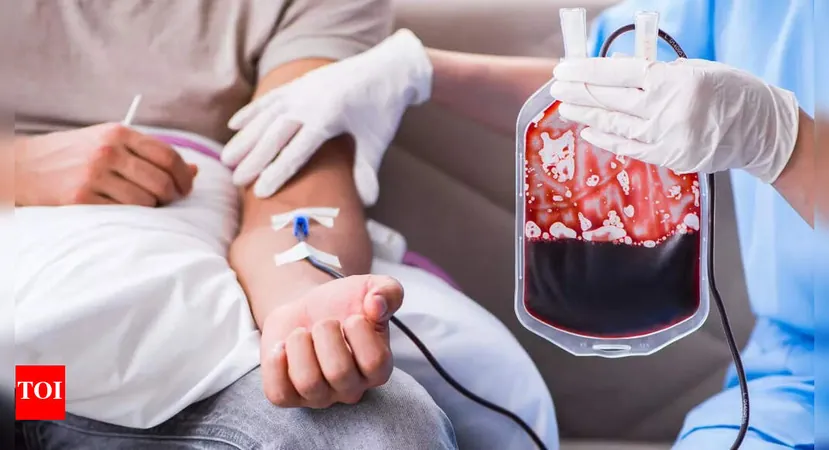
Unraveling the Mystery: Why Men Face a Greater Blood Cancer Risk than Women
2025-09-14
Author: Daniel
The Alarming Truth About Lymphoma Risk
Lymphoma, a threatening form of blood cancer, shows a striking gender disparity, affecting men significantly more than women. Recent studies reveal that men not only encounter higher odds of developing this disease—both non-Hodgkin and Hodgkin lymphomas—but also grapple with more aggressive versions and poorer prognoses. What lies behind this concerning trend?
Hormonal Differences: The Showdown of Estrogen vs. Testosterone
At the heart of this disparity are biological and hormonal differences between the sexes. Women benefit from protective hormones like estrogen and progesterone, which bolster the immune system and stave off the transformation of lymphocytes into cancerous cells. Those with higher lifetime exposure to estrogen—whether through pregnancy, menstrual cycles, or hormonal treatments—appear to enjoy a significant defense against lymphoma. Research from the NIH indicates that men are at a much higher risk for 14 out of 16 lymphoma subtypes, with hormonal influences playing a crucial role. While estrogen works to shield women, testosterone may unwittingly facilitate abnormal lymphocyte growth in men, creating a climate ripe for lymphoma.
The Battle of Immune Responses
Another critical factor is the strength of immune systems between the genders. Women typically exhibit stronger immune responses, allowing them to better detect and eliminate abnormal cells. This advantage can largely be attributed to genetic factors, notably the presence of two X chromosomes in women, which enhances immune surveillance. In contrast, men’s single X chromosome makes them more vulnerable, as their immune systems are less effective at spotting potential threats, leading to increased likelihood of cancer development.
Environmental Hazards: The Occupational Risk Factor
But it's not just biology at play; environmental exposures contribute significantly to this disparity. Men often work in industries where exposure to carcinogenic chemicals is commonplace—think farming, landscaping, or construction. Jobs in these fields frequently entail contact with harmful pesticides and industrial chemicals linked to a spike in lymphoma cases, demonstrating the environmental angle of this health dilemma.
Size Matters: Body Dimensions and Cancer Risk
Interestingly, body size is also a factor. On average, men are larger than women, a characteristic that correlates with higher cancer risks. A larger body size tends to lead to increased stem cell divisions and heightened exposure to growth factors, raising the chances of mutations that may result in cancer.
Genetic Vulnerabilities: A One-X Chromosome Disadvantage
When it comes to genetics, men face unique challenges. Women possess two X chromosomes, providing them with robust immune defenses and a genetic 'backup' against mutations. In contrast, men—with just one X chromosome—are at a heightened risk for genetic mutations that can lead to cancerous developments.
Taking Charge: Preventive Measures for Both Genders
While some risk factors are immutable, there’s hope through awareness and proactive lifestyle choices. Reducing exposure to carcinogens, particularly in occupational settings, is vital. This can include safer farming practices, stringent pesticide regulations, and adequate protective gear for workers. Both men and women should focus on adopting healthier lifestyles and engaging in regular health screenings for early detection—a particularly vital strategy for men, given their elevated baseline risk.
Concluding Thoughts
In summary, the higher incidence of lymphoma in men arises from a cocktail of hormonal, immune, occupational, genetic, and biological factors. While women enjoy protective hormones and greater immunity, men bear the brunt of testosterone's dangerous effects alongside increased exposure to carcinogens. By unraveling these complex differences, we can pave the way for better awareness, preventative strategies, and treatment outcomes for lymphoma patients.




 Brasil (PT)
Brasil (PT)
 Canada (EN)
Canada (EN)
 Chile (ES)
Chile (ES)
 Česko (CS)
Česko (CS)
 대한민국 (KO)
대한민국 (KO)
 España (ES)
España (ES)
 France (FR)
France (FR)
 Hong Kong (EN)
Hong Kong (EN)
 Italia (IT)
Italia (IT)
 日本 (JA)
日本 (JA)
 Magyarország (HU)
Magyarország (HU)
 Norge (NO)
Norge (NO)
 Polska (PL)
Polska (PL)
 Schweiz (DE)
Schweiz (DE)
 Singapore (EN)
Singapore (EN)
 Sverige (SV)
Sverige (SV)
 Suomi (FI)
Suomi (FI)
 Türkiye (TR)
Türkiye (TR)
 الإمارات العربية المتحدة (AR)
الإمارات العربية المتحدة (AR)